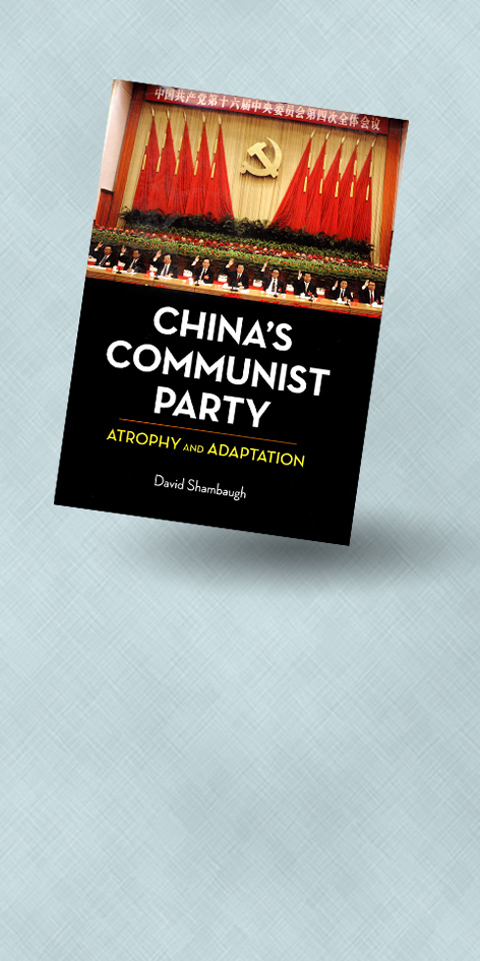Following the collapse of communism in the Soviet Union and Eastern Europe in the late 1980s and early 1990s, predictions that the Chinese Communist Party (CCP) was next became in fashion. While the “pessimists” have made careers predicting chaos, fissiparous dissolution or a military takeover in China, the “optimists” have argued that a democratic spring is just around the corner. In most instances, those prognostications were predicated on a monolithic CPP that is little more than a Chinese version of the Communist Party of the Soviet Union (CPSU).
In China’s Communist Party: Atrophy and Adaptation, David Shambaugh, director of the China Policy program at George Washington University, argues that the CCP has been anything but complacent since the fall of the Soviet Union and that, above all, its principal objective has been to ensure its survival.
Little known to most, the CCP and the various academic centers that fall under its purview have expended a tremendous amount of intellectual capital studying the many variables that, combined, resulted in the collapse of the CPSU and other communist governments around the world. In fact, by looking at systemic causes (economic; political/coercive; social/cultural; international), Chinese analyses of what went wrong for the Soviet Union were far more thorough than Western accounts, which tended to see Mikhail Gorbachev as the principal cause of the CPSU’s demise. In China’s view, the Soviet apparatus had become far too atrophied, too top-heavy, not flexible enough and too dogmatic, while Gorbachev’s intervention came too late, too fast, and in many ways was misguided, as it sought to emulate the Western model. As such, rather than the proximate cause of the Soviet Union’s implosion, Gorbachev was its trigger (this partly explains why former leader Zhao Ziyang (趙紫楊), whose “humanist” views echoed Gorbachev’s, was quickly sidelined following the Tiananmen Square Massacre in 1989).

Beijing’s curiosity, Shambaugh shows, went much further than the Soviet Union and included surprisingly detailed comparative assessments of other former communist states, surviving ones — North Korea, Vietnam and Cuba — the “Color Revolutions” in the Central Asian republics, noncommunist, single-party states like Singapore and Malaysia, European socialism, and the Chinese Nationalist Party (KMT) in China in the 1940s and in Taiwan in the 1980s and 1990s. Furthermore, those efforts were far more than abstract intellectual inquiry; rather, they were undertaken “for very specific and practical reasons: to anticipate what generic challenges to the CCP may arise.”
Based on the lessons learned, the CCP has embarked on a reactive and proactive strategy of “dynamic stability” to perpetuate its power, and unlike claims to the contrary, has demonstrated an impressive capacity for adaptation and far more flexibility and open-mindedness than it has been credited for. It has also shown that, rather than a monolithic, atrophied entity, the CCP has gradually shifted its policies in line with the economic development of the country and its effect on the demands of the population. Jiang Zemin’s (江澤民) “Three Represents” and Hu Jintao’s (胡錦濤) “Scientific Development” and “Sociality Harmonious Society” paradigms show a progression in thought and greater attention — especially under Hu and Wen Jiabao (溫家寶), who, unlike the “coastal” Jiang, worked in the interior provinces — to the needs of the masses.
To meet the increasingly complex challenges of a developing China, the CCP has also professionalized itself, sought, with some success, to fight corruption, and streamlined its ranks.
Consequently, the 16th Party Congress in 2002 experienced its highest turnover of party members ever and resulted in the most educated CPP in the party’s history. Guided by the “Decision of the CPC Central Committee on Enhancing the Party’s Ruling Capacity” (2004), the party also implemented a series of unprecedented reforms at the ideological and organizational levels, introduced mechanisms, or “Opinions,” to evaluate party cadres, and imposed mid-career training.
Despite all this, the challenges to the CCP are rife. As China transforms, the top-to-bottom penetration of society under a Leninist system has become more difficult to achieve. Social and professional organizations that operate outside the CPP have proliferated, and as communist ideology loses its appeal with the masses and the private sector becomes increasingly independent, party committees have lost their strength as the sole source of legitimacy and purveyance. Rather than crack down or turn back the clock as we would expect of a monolithic authoritarian system, however, the CCP has chosen to experiment with consultative models (the Chinese People’s Political Consultative Congress) and tentatively introduced democracy within the party. It has also increasingly turned Marxist ideology, which the population sees with growing cynicism, into a more nationalistic discourse, and let reality guide ideology rather than the other way around.
There are, however, certain areas where CPP thought has remained inflexible. Its fear of China becoming a “bourgeois vassal state” and paranoid view of the US continues to inform its policies on mass media and non-governmental organizations, which it sees as Trojan Horses meant to topple it — a view that was reinforced by its assessment of the “Color Revolutions.” The CCP has also retained its zero-sum relationship with civil society and zero tolerance for organized opposition outside the party. As the challenges brought about by China’s industrialization and rapid development will only increase, the failure to allow more diversity in the political sphere — in other words to democratize outside the party — may very well be the seeds of the CPP’s demise, and the 60 to 100 years it says are needed before democracy can be fully implemented may just be too long a wait for a population whose demands, expectations and awareness will continue to grow.
But as Shambaugh demonstrates in this rich and extremely helpful guide to how the CCP has viewed itself and the world since the spring of 1989, we should not underestimate its capacity to see the challenges ahead and make the necessary adjustments to ensure the perpetuation of its rule. While the author’s views of the CCP’s successes — especially when it comes to ethnic minorities such as Tibetans and Uyghurs — may be overoptimistic, his book nevertheless makes predictions of the CCP’s inexorable collapse less plausible.

The 1990s were a turbulent time for the Chinese Nationalist Party’s (KMT) patronage factions. For a look at how they formed, check out the March 2 “Deep Dives.” In the boom years of the 1980s and 1990s the factions amassed fortunes from corruption, access to the levers of local government and prime access to property. They also moved into industries like construction and the gravel business, devastating river ecosystems while the governments they controlled looked the other way. By this period, the factions had largely carved out geographical feifdoms in the local jurisdictions the national KMT restrained them to. For example,

The remains of this Japanese-era trail designed to protect the camphor industry make for a scenic day-hike, a fascinating overnight hike or a challenging multi-day adventure Maolin District (茂林) in Kaohsiung is well known for beautiful roadside scenery, waterfalls, the annual butterfly migration and indigenous culture. A lesser known but worthwhile destination here lies along the very top of the valley: the Liugui Security Path (六龜警備道). This relic of the Japanese era once isolated the Maolin valley from the outside world but now serves to draw tourists in. The path originally ran for about 50km, but not all of this trail is still easily walkable. The nicest section for a simple day hike is the heavily trafficked southern section above Maolin and Wanshan (萬山) villages. Remains of

With over 100 works on display, this is Louise Bourgeois’ first solo show in Taiwan. Visitors are invited to traverse her world of love and hate, vengeance and acceptance, trauma and reconciliation. Dominating the entrance, the nine-foot-tall Crouching Spider (2003) greets visitors. The creature looms behind the glass facade, symbolic protector and gatekeeper to the intimate journey ahead. Bourgeois, best known for her giant spider sculptures, is one of the most influential artist of the twentieth century. Blending vulnerability and defiance through themes of sexuality, trauma and identity, her work reshaped the landscape of contemporary art with fearless honesty. “People are influenced by

April 14 to April 20 In March 1947, Sising Katadrepan urged the government to drop the “high mountain people” (高山族) designation for Indigenous Taiwanese and refer to them as “Taiwan people” (台灣族). He considered the term derogatory, arguing that it made them sound like animals. The Taiwan Provincial Government agreed to stop using the term, stating that Indigenous Taiwanese suffered all sorts of discrimination and oppression under the Japanese and were forced to live in the mountains as outsiders to society. Now, under the new regime, they would be seen as equals, thus they should be henceforth